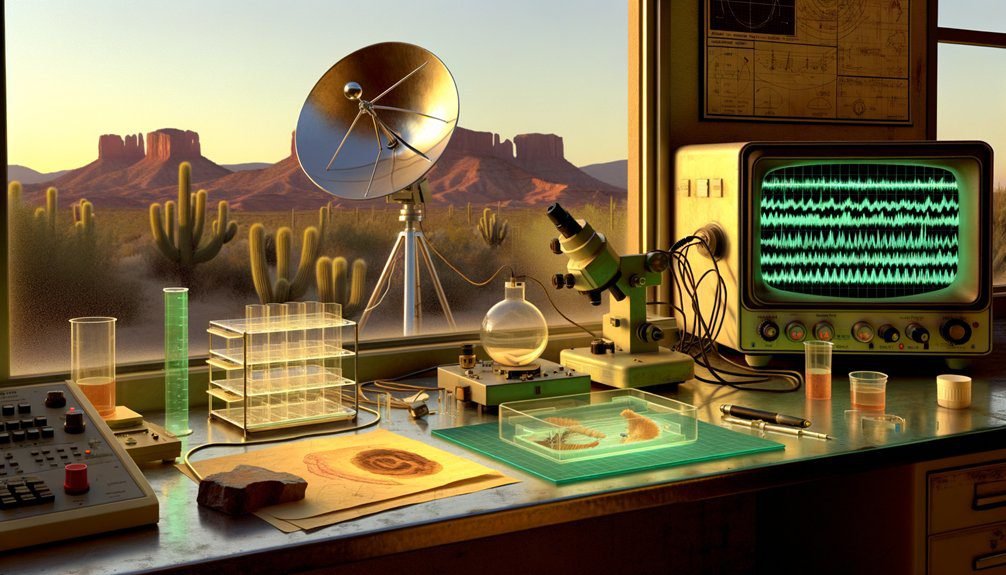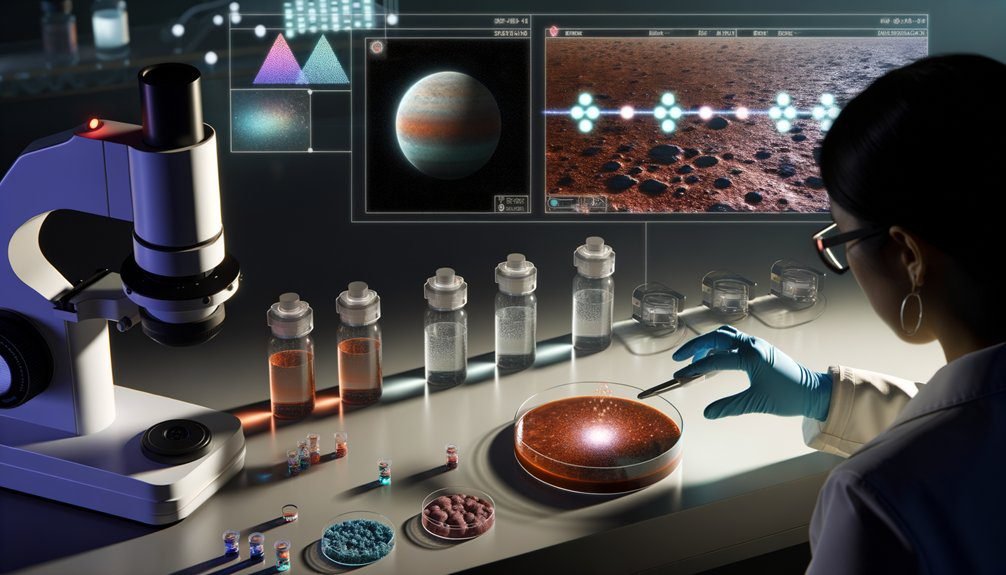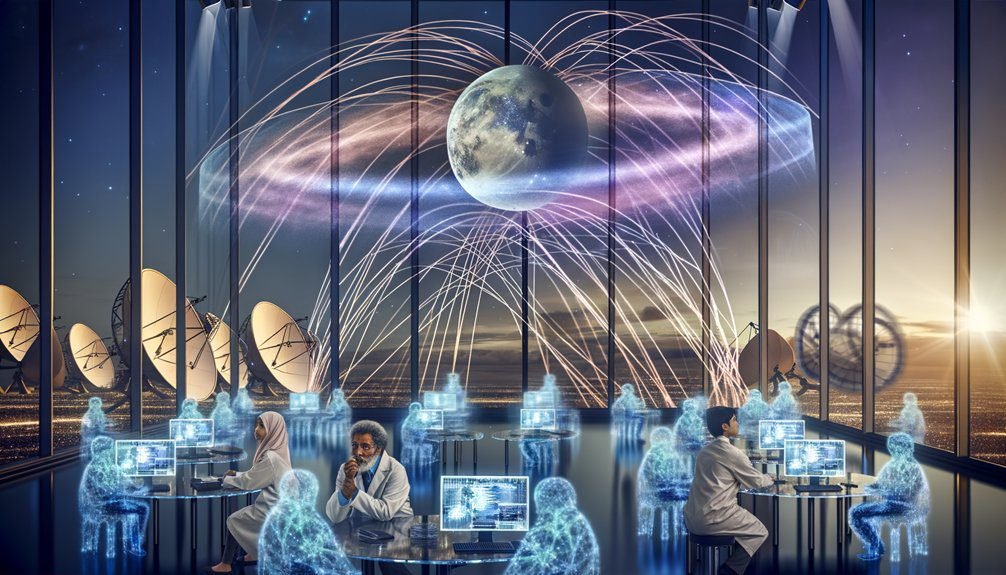You’ll start by learning SETI’s shift from speculation to repeatable experiments, then practice radio-telescope calibration, interference mitigation, and spectral analysis to spot credible signals. You’ll combine planetary remote sensing, lab analogs, and geochemistry to test biosignatures, and apply statistical vetting to avoid false alarms. You’ll weigh cosmological context and ethics, and join collaborative networks for verification and public transparency. Keep going and you’ll uncover step-by-step protocols, tools, and community pathways to actually make discoveries.
Key Takeaways
- Define clear objectives: decide whether you seek microbial biosignatures, technosignatures, or habitability indicators, and set measurable criteria.
- Choose appropriate instruments and methods: combine telescopes, spectroscopy, and in situ probes tailored to target environment and signal types.
- Implement robust data pipelines: calibrate instruments, mitigate interference, and apply statistical algorithms to control false-alarm rates.
- Cross-validate findings: use laboratory analogs, independent observations, and interdisciplinary review before claiming detection.
- Follow protocols for communication and governance: share data securely, coordinate verification networks, and plan transparent public outreach.
The Origins and Evolution of SETI Research

When you trace SETI back to its roots, you find a line of ideas and experiments that steadily shifted from philosophy to empirical science. You’ll notice early speculation about extraterrestrial life gave way to targeted observation as telescopes and radio technology matured. In SETI history, pioneers proposed measurable criteria for what would count as a communicative signal, and they designed searches to reduce ambiguity. You follow laboratory and field work that emphasized repeatability, calibration, and the elimination of natural and human-made interference. As you study program reports and published results, you see evolving frameworks for prioritizing frequency bands, observing time, and candidate validation. Your focus will be on documented milestones: the first systematic sky surveys, interdisciplinary collaborations, and methodological refinements that improved confidence in signal detection claims. This lineage shows you how SETI moved toward standardized protocols, so when an anomalous pattern appears today, you know the investigative steps grounded in evidence and skepticism.
Radio Astronomy Techniques and Signal Processing
Although radio astronomy looks at the sky through a different lens than optical telescopes, you’ll find its core practices are just as rigorous: precise calibration, careful noise characterization, and layered signal-processing pipelines that turn raw voltages into testable candidates. You’ll focus on telescope calibration and data normalization first, then apply interference mitigation so genuine signals survive. Frequency analysis and spectral imaging reveal narrowband or drifting features; pulse recognition isolates transient bursts. Signal detection depends on algorithm development tuned to false-alarm rates, and you’ll validate candidates with repeatability and multi-beam coincidence. Keep a lab notebook of parameter choices and statistical thresholds, and iterate: change filters, rerun frequency-domain searches, compare time-domain pulse stacks. The evidence-driven cycle — observe, preprocess, search, vet — keeps discovery claims robust. Below is a compact guidance table summarizing trade-offs and priorities.
| Task | Priority |
|---|---|
| Telescope calibration | High |
| Interference mitigation | High |
| Frequency analysis | Medium |
| Pulse recognition | Medium |
Interdisciplinary Impacts on Astrobiology and Planetary Science

Because radio astronomy techniques shape what we can detect and interpret, you’ll find astrobiology and planetary science increasingly intertwined with signal-processing choices and calibration limits. You’ll approach questions about biological signatures and chemical markers with tools from physics, chemistry, and computational statistics, so your hypotheses are testable across disciplines. When evaluating planetary environments, you’ll combine remote-sensing spectra, in situ geochemistry, and climate modeling to constrain habitability windows and plausible evolutionary pathways. You’ll weigh detection thresholds against false positives, using laboratory analogs and comparative planetology to validate interpretations. Collaborative workflows will let you translate noisy data into probabilistic statements about life’s likelihood without overclaiming. You’ll design experiments that target concordant indicators — molecular ratios, isotopic patterns, and contextual geology — because convergent evidence is what shifts tentative signals toward confidence. Staying methodical, you’ll document assumptions, propagate uncertainties, and update models as new measurements refine the search for life beyond Earth.
Cosmological Implications of Detecting Technosignatures
If we confirmed a technosignature, you’d immediately face cosmological questions about how such a signal fits into models of life, intelligence, and the universe’s history. You’d assess evidence: signal properties, distance, energy budget, and statistical likelihood versus natural phenomena. That assessment would inform models of cosmic distribution of intelligence, altering priors in Drake-like equations and prompting reevaluation of emergence timescales and longevity assumptions. You’d consider whether a detected technology implies convergent evolution of cognition or rare, contingent pathways. Evidence-driven scenarios would lead you to examine impacts on cosmology itself: constraints on habitable epochs, energy use detectable across cosmological volumes, and implications for entropy and information theory. Alongside scientific inference, you’d need to integrate ethical frameworks—extraterrestrial ethics—into decision-making about response and preservation. Anticipating and measuring societal reactions, you’d plan transparent, measured communications to avoid misinterpretation, supporting public understanding without overclaiming certainty.
Collaborative Networks, Data Sharing, and Public Engagement

When a potential technosignature emerges, you’ll need collaborative networks that bring together astronomers, data scientists, ethicists, and communication specialists to verify, interpret, and decide on next steps. You’ll establish data-sharing protocols, standardized metadata, and secure repositories so multiple teams can reproduce analyses quickly. You’ll set clear governance: who has access, how decisions are escalated, and how sensitive information is handled. You’ll also plan for community outreach and public awareness, creating transparent timelines and messaging that avoid hype. Citizen science platforms can broaden validation efforts and provide independent checks while engaging the public in meaningful work. Educational initiatives should translate technical findings into teachable modules for schools and museums, fostering long-term scientific literacy. You’ll document every step, log uncertainties, and publish methods and raw data where possible to enable scrutiny. By combining rigorous procedures with responsible outreach, you’ll balance rapid verification, ethical considerations, and an informed public dialogue.
Frequently Asked Questions
How Can Amateurs Participate in SETI From Home?
You can join SETI from home by running home projects like radio-signal monitoring or optical-sky imaging and contributing data analysis to citizen-science platforms. Start methodically: pick affordable equipment, follow reproducible observing protocols, and log calibration steps. Use established tools and share raw datasets for peer review, letting evidence guide conclusions. Stay curious, document anomalies, and collaborate with online communities to validate findings and improve your methods over time.
What Legal Issues Arise if We Receive an Alien Message?
You’d face questions about ownership, disclosure, and national security when alien communication arrives; international treaties and domestic laws might not clearly cover extraterrestrial messages. You’d need to document evidence, preserve chain of custody, and coordinate with scientific bodies and legal authorities. Privacy, frequency-use rules, and liability for replies could matter. You’d want transparent, treaty-aware procedures, expert review, and multinational cooperation to guarantee lawful, evidence-driven handling and public trust.
Could Extraterrestrial Microbes Contaminate Earth Samples?
Yes — you could unintentionally introduce extraterrestrial microbes into Earth samples, so you’ll need strict planetary protection measures to prevent microbial contamination. You’ll methodically assess risks, use sterilized protocols, and rely on evidence-based quarantine and testing to detect unknown organisms. You’ll prioritize containment, transparent reporting, and iterative verification. By staying curious but cautious, you’ll balance scientific discovery with protecting Earth’s biosphere through rigorous, documented procedures.
How Would Contact Affect Global Religions and Cultures?
Roughly 8 billion people could rethink meaning if contact were confirmed; you’d see faith adaptation unfold as communities reassess doctrines. You’d witness belief transformation driven by evidence, debates, and ritual innovation. Some traditions would integrate new cosmologies, others’d double down on existing interpretations. You’d track surveys, sermons, and migration of ideas to gauge change. Over years, cultural practices, law, and art would reflect a methodical negotiation between proof and preexisting faith.
What Technologies Could Allow Human Interstellar Travel?
You could use fusion rockets, antimatter drives, warp drives, or long-duration cryogenic ships; near-term options include nuclear thermal and beamed propulsion. Solar sails and laser-pushed lightsails offer low-mass, high-Δv travel for probes. Each concept demands solving propulsion efficiency, energy storage, radiation shielding, and navigation across light-years. Evidence-driven research and incremental tests—lab, orbital, then interstellar probes—will refine feasibility, costs, and timelines before crewed missions become plausible.